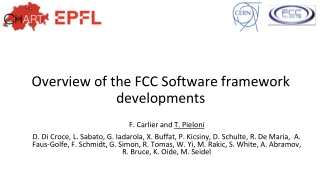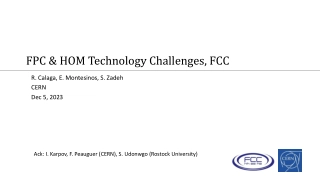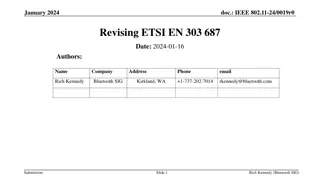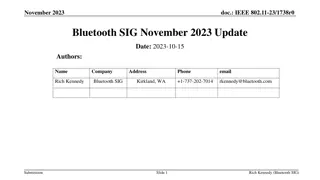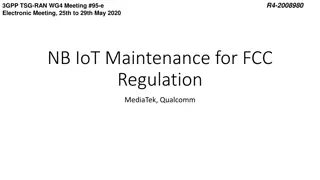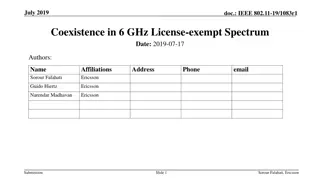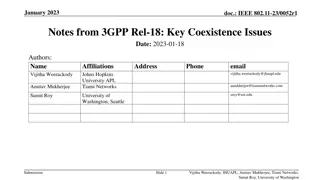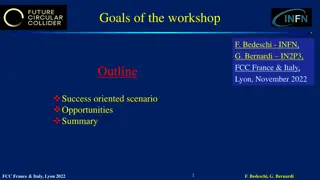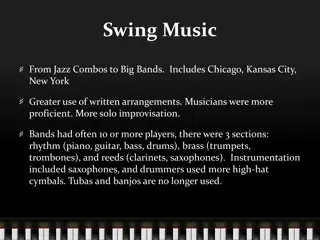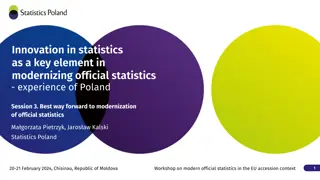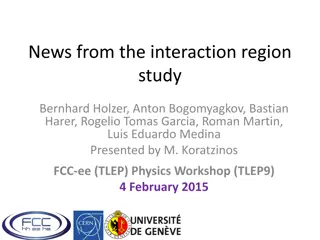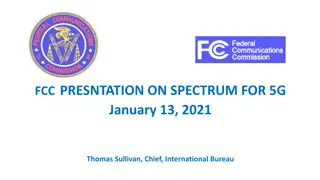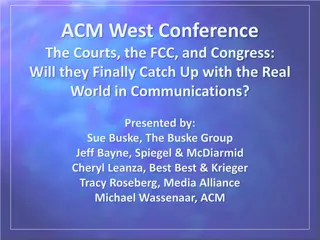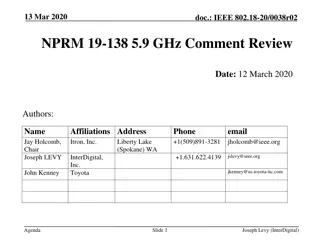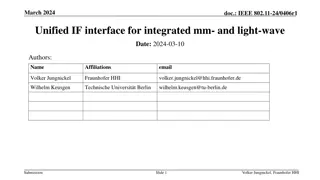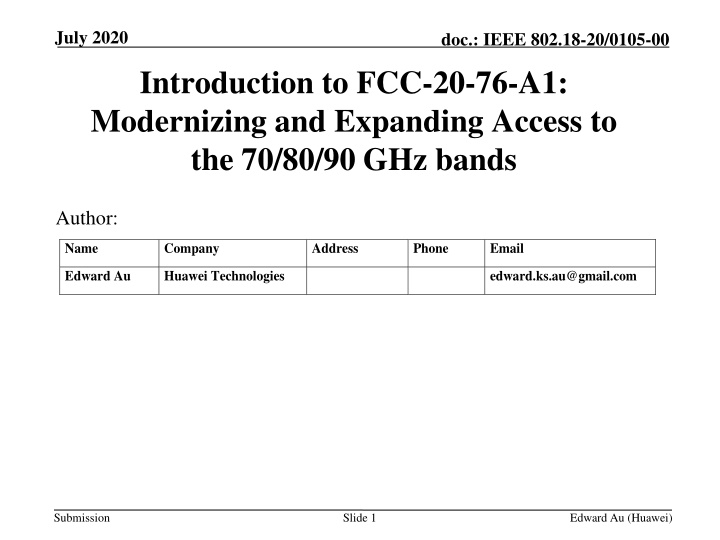
Introduction to FCC-20-76-A1: Modernizing and Expanding Access to the 70/80/90 GHz Bands by Edward Au
Explore the document discussing the FCC-20-76-A1 initiative focusing on modernizing and expanding access to the 70/80/90 GHz bands. Edward Au from Huawei Technologies provides insights into the frequency bands of interest, existing allocations, service rules for non-federal use, motivation behind the rulemaking, and more to support wireless backhaul for 5G and broadband services while safeguarding incumbent operations.
Download Presentation

Please find below an Image/Link to download the presentation.
The content on the website is provided AS IS for your information and personal use only. It may not be sold, licensed, or shared on other websites without obtaining consent from the author. If you encounter any issues during the download, it is possible that the publisher has removed the file from their server.
You are allowed to download the files provided on this website for personal or commercial use, subject to the condition that they are used lawfully. All files are the property of their respective owners.
The content on the website is provided AS IS for your information and personal use only. It may not be sold, licensed, or shared on other websites without obtaining consent from the author.
E N D
Presentation Transcript
July 2020 doc.: IEEE 802.18-20/0105-00 Introduction to FCC-20-76-A1: Modernizing and Expanding Access to the 70/80/90 GHz bands Author: Name Company Address Phone Email Edward Au Huawei Technologies edward.ks.au@gmail.com Submission Slide 1 Edward Au (Huawei)
July 2020 doc.: IEEE 802.18-20/0105-00 Frequency bands of interest 71-76 GHz 81-86 GHz 92-94 GHz 94.1-95 GHz All are subject to 47 CFR Part 101.1501 to Part 101.1527 (Fixed Microwave https://www.law.cornell.edu/cfr/text/47/part-101 Services) at Submission Slide 2 Edward Au (Huawei)
July 2020 doc.: IEEE 802.18-20/0105-00 Existing Allocations (Co-Primary Basis) Band 71-74 GHz Non-Federal Use Fixed, Fixed Satellite, Mobile, and Mobile Satellite Fixed, Fixed Satellite, Mobile, Broadcasting, and Broadcasting Satellite Fixed, Fixed Satellite, Mobile, Mobile Satellite, and Radio Astronomy Fixed, Fixed Satellite, Mobile, and Radio Astronomy Fixed, Mobile, Radio Astronomy, and Radiolocation Federal Use Fixed, Fixed Satellite, Mobile, and Mobile Satellite Fixed, Fixed Satellite, and Mobile 74-76 GHz 81-84 GHz Fixed, Fixed Satellite, Mobile, Mobile Satellite, and Radio Astronomy Fixed, Fixed Satellite, Mobile, and Radio Astronomy Fixed, Mobile, Radio Astronomy, and Radiolocation 84-86 GHz 92-94 GHz, 94.1-95 GHz Submission Slide 3 Edward Au (Huawei)
July 2020 doc.: IEEE 802.18-20/0105-00 Existing service rules for non-federal use (point to point, non-broadcast service) A two-pronged, non-exclusive licensing regime 1) An entity may apply for a nationwide, non-exclusive license for the entire 12.9 gigahertz of the 70/80/90 GHz bands. 2) A licensee may operate links after completing coordination with Federal operations through NTIA s database and after providing an interference analysis to one of the third-party database managers. As of March 23, 2020: 658 active non-exclusive nationwide licensees 18,770 registered fixed links Submission Slide 4 Edward Au (Huawei)
July 2020 doc.: IEEE 802.18-20/0105-00 Motivation this rulemaking and order To facilitate the provision of wireless backhaul for 5G, as well as the deployment of broadband services to aircraft and ships, while protecting incumbent operations in the 70/80/90 GHz bands. NOTE The Commission is revisiting in this rulemaking its decision in the 2017 Spectrum Frontiers Order not to allow mobile service in the 70/80/90 GHz bands, given the evolution in technology. Submission Slide 5 Edward Au (Huawei)
July 2020 doc.: IEEE 802.18-20/0105-00 Scope of this rulemaking and order Propose changes to the antenna standards applicable to the 70 GHz and 80 GHz bands and seek comment on whether similar changes are necessary in the 90 GHz band; Should the Commission make changes to its current link registration rules for the 70/80/90 GHz bands to eliminate never-constructed links from the database? Proposes to authorize point-to-point links to endpoints in motion in the 70 GHz and 80 GHz bands and to classify those links as a mobile service; Seek comment on any technical and operational rules that would be needed to allow these new service offerings in the 70 GHz and 80 GHz bands and to mitigate interference to incumbents and other proposed users of these bands and in adjacent bands. Should the Commission adopt a channelization plan in the 70 GHz and 80 GHz bands? Submission Slide 6 Edward Au (Huawei)
July 2020 doc.: IEEE 802.18-20/0105-00 Relevant to IEEE 802? Even though this notice of proposed rulemaking and order focuses on 5G backhaul and the communications to ships and aircrafts, it did ask whether any changes of Part 101 rules necessary to accommodate other potential uses of the 70/80/90 GHz bands, and whether any other rule changes help to promote innovative use of the 70/80/90 GHz bands. Submission Slide 7 Edward Au (Huawei)
July 2020 doc.: IEEE 802.18-20/0105-00 5G Backhaul: Antenna Rules Existing rule: The Commission s rules currently apply a single category of antenna standards to the 70 GHz band and the 80 GHz band. Proposed change: Increase the maximum beamwidth by 3 dB points from 1.2 degrees to 2.2 degrees, reduce minimum antenna gain from 43 dBi to 38 dBi and to retain the proportional EIRP reduction requirement. Seek comment on whether the current stricter co-polar and cross-polar discrimination requirements are now unnecessary. Seek comment on whether the Commission allow 45 degree polarization (also known as slant polarization) in the 70 GHz and 80 GHz bands. Seek comment on whether to adopt an additional antenna standard, Category B, applicable to the 70 GHz and 80 GHz bands, which could permit less restrictive use under certain circumstances than the proposed modified antenna standards (which would be the accompanying Category A standards). Seek comment on whether any of the changes discussed in this Notice or other changes should apply to the 90 GHz band. Slide 8 Submission Edward Au (Huawei)
July 2020 doc.: IEEE 802.18-20/0105-00 5G Backhaul: Link Registration Rules Existing rule: Licensees in the 70/80/90 GHz bands must complete construction and bring into regular use registered links within 12 months of the date on which a third-party database manager registers the link. Currently, the Commission relies on licensees to notify database managers to withdraw unconstructed links from the database. Proposed change: Should the Commission require 70 GHz and 80 GHz band registrants to file a certification of construction when a link has been placed in operation? Should different rules apply for registrants in the 90 GHz band? What changes, if any, should the Commission make to its rules to ensure that registrations accurately reflect actual use of the 70/80/90 GHz bands? Submission Slide 9 Edward Au (Huawei)
July 2020 doc.: IEEE 802.18-20/0105-00 Communications to Ships and Aircrafts: Authorization Framework Existing rule: Point-to-point links to endpoints in motion are not allowed to operate in the 70/80/90 GHz bands. Proposed change: Propose to authorize point-to-point links to endpoints in motion in the 70 GHz and 80 GHz bands under Part 101 rules. Seek comment on whether the introduction of these new types of services in these bands would affect existing point-to-point microwave services or the potential for deployment of other non-Federal and Federal services in the bands, and how to continue to protect co-primary and adjacent Federal operations. Seek comment on what changes to the 70/80/90 GHz coordination, licensing, and registration framework would be necessary to permit the operation of links to endpoints in motion under Part 101.105. Propose to continue licensing use of the 70 GHz and 80 GHz bands on a non- exclusive, nationwide basis, and require coordination and registration of all air- and sea- based links/links between antennas in motion, Submission Slide 10 Edward Au (Huawei)
July 2020 doc.: IEEE 802.18-20/0105-00 Communications to Ships and Aircrafts: Technical & Operational Rules Proposed change: Increase the maximum allowable mobile EIRP for 71 76 GHz and 81 86 GHz from +55 dBW to +57 dBW. Increase the maximum transmitter power from 3 watts (5 dBW) to 5 watts (7 dBW). Increase the maximum transmitter power spectral density from 150 mW per 100 MHz to 500 mW per 100 MHz. Seek comments on not only the proposed changes but also on whether the technical rules would increase the potential for harmful interference to those vehicular radars operating in the 76-81 GHz band as well as passive services in the 86-92 GHz band. Submission Slide 11 Edward Au (Huawei)
July 2020 doc.: IEEE 802.18-20/0105-00 Communications to Ships and Aircrafts: Channelization plan Existing rule: None The Commission eliminated the 1.25 GHz segments in 2005 that necessitate development of a channel plan. Proposed change: Seek comment on whether the Commission develops a channel plan for the 70 GHz and 80 GHz bands. Would establishing a channel plan restrict the development of innovative equipment for the bands, as the Commission feared in 2005? Seek comment on whether authorizing links to endpoints in motion requires the Commission to adopt a formal channel plan for the 70/80/90 GHz bands. If the Commission were to adopt a channel plan, then what channel plan should it use? Should the Commission revise section 101.109(c) of the Part 101 rules to specify a maximum bandwidth less than 5,000 MHz for the 70 GHz and 80 GHz bands? Should the Commission increase the minimum bit rate of 0.125 bits per second per Hz to, for example, 1 bit per second per Hz? Submission Slide 12 Edward Au (Huawei)
July 2020 doc.: IEEE 802.18-20/0105-00 Communications to Ships and Aircrafts: Others Seek comments on Are any other rule changes necessary to accommodate other potential uses of the 70/80/90 GHz bands? Would any other rule changes help to promote innovative use of the 70/80/90 GHz bands? Submission Slide 13 Edward Au (Huawei)

